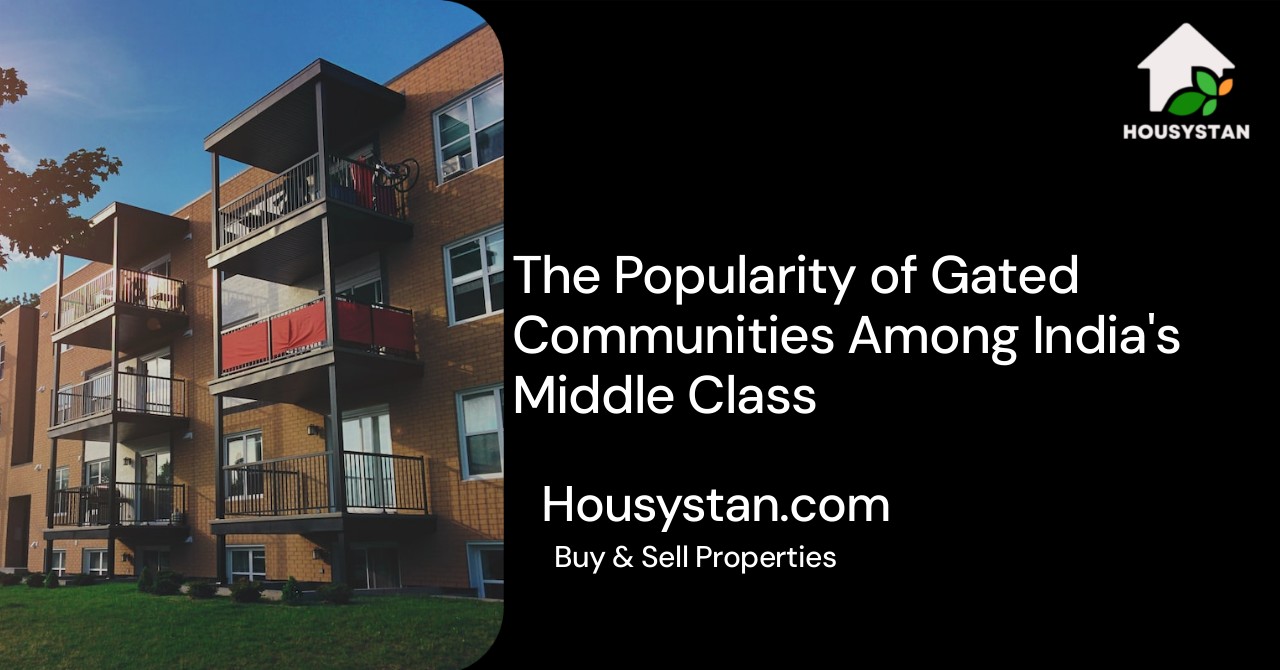The Popularity of Gated Communities Among India's Middle Class
Read latest blogs and articles from Housystan

The Information mentioned here was last updated on:
31/12/2025Why Gated Communities Are Gaining Popularity Among India’s Middle Class
In recent years, India has witnessed a distinct trend among its middle-class population: the rise of gated communities. This phenomenon has emerged as a significant shift in residential preferences, reshaping the landscape of urban living in the country. Let’s delve into the reasons behind this growing popularity, and understand what makes gated communities an attractive option for India’s burgeoning middle class.
Security: A Top Priority
- Verified Tenants/Buyers
- Unlimited Property Listing
- Zero subscription/charges fee
One of the foremost reasons why gated communities are becoming increasingly popular among the middle class in India is the promise of enhanced security. In many urban areas, concerns about safety and crime have led residents to seek environments that provide peace of mind. Gated communities offer 24/7 security, CCTV surveillance, and restricted access, ensuring that only authorized individuals enter the premises. This comprehensive approach to safety makes residents feel protected, offering them a sanctuary away from the uncertainties of urban life.
Infrastructure and Amenities
Gated communities are often equipped with a wide range of modern amenities that cater to the lifestyle aspirations of the middle class. These may include swimming pools, sports complexes, parks, meditation centers, clubhouses, and more. The convenience of having these facilities within close proximity eliminates the need for residents to look elsewhere for leisure and recreation. Additionally, gated communities often boast well-maintained roads, reliable waste management systems, and consistent power and water supply, enhancing the overall quality of life.
Sense of Community
Living in a gated community fosters a strong sense of belonging and community among residents. With frequent social events, festivals, and gatherings organized within the premises, residents have ample opportunities to interact, socialize, and form lasting connections. This sense of camaraderie makes these communities feel more like small towns within larger cities, where neighbors know each other and mutual support is a staple of daily life. For many in India’s middle class, this sense of unity and togetherness is a key factor in choosing a gated community over a standalone residence.
Urbanization and Space Constraints
As cities continue to expand and population densities increase, the scarcity of land has become a pressing issue. Gated communities offer a counterbalance to the cramped living conditions often found in densely populated urban areas. These communities are typically designed to maximize the use of available space while maintaining a sense of openness and environmental harmony. Lush green landscapes, spacious layouts, and a focus on environmental sustainability provide residents with an escape from the concrete jungle, offering them a piece of tranquility amidst the urban chaos.
Investment Potential
For many, purchasing property in a gated community is not just about the present lifestyle benefits but also a strategic investment for the future. Gated communities often witness rapid appreciation in property value due to their desirable offerings and prime locations. As a result, they attract investors hoping to capitalize on resale opportunities. Additionally, the demand for rental properties in such communities remains robust, offering a reliable income stream for property owners.
Location and Connectivity
When it comes to choosing a place to live, location plays a crucial role. Gated communities are often strategically situated on the outskirts of major cities or in rapidly developing suburban areas. This ensures residents are well-connected to urban amenities, business districts, and educational institutions, while still enjoying the benefits of quieter, cleaner environments. The connectivity and proximity to essentials make gated communities particularly appealing to working professionals and families alike.
Quality of Life
Beyond the tangible benefits, gated communities offer an intangible improvement in the quality of life. The ability to live in an environment that is stress-free, secure, and filled with recreational opportunities is invaluable. For the middle class, rising disposable incomes and changing lifestyle aspirations have made the pursuit of such a quality of life more achievable than ever before. The shift toward work-life balance and personal well-being further propels individuals toward housing options that promise a harmonious living experience.
Changing Social Trends
India’s rising middle class is characterized by changing social trends and an evolving ideology. The new generation values privacy, convenience, and a cosmopolitan lifestyle, all of which are fundamental components of contemporary gated communities. As traditional joint-family structures give way to nuclear families, the demand for housing options that accommodate modern lifestyles with independence and privacy continues to grow.
Eco-friendliness and Sustainable Living
With increasing awareness about environmental issues, many gated communities emphasize sustainable living practices. These communities often incorporate eco-friendly technologies, such as rainwater harvesting, solar energy systems, and waste recycling programs. The presence of green spaces and pollution-free environments contributes to healthier living, making them an attractive choice for environmentally conscious residents.
Educational and Health Facilities
Proximity to quality schools and healthcare facilities is a significant consideration for families when choosing a place to live. Many gated communities are located near reputed educational institutions and hospitals or even include them within the premises. It ensures that families have ready access to essential services, which alleviates the burden of long commutes for daily needs, adding to the overall convenience.
Technological Advancements
Integration of technology in gated communities is another aspect that appeals to the tech-savvy middle class. Smart home features, automated security systems, and seamless home automation align with the expectations of modern living, offering residents convenience and control at their fingertips. This adoption of technology further differentiates gated communities from traditional housing options.
This profound shift toward gated communities among India’s middle class is a reflection of evolving priorities, improved spending power, and an aspiration for a more balanced lifestyle. The demand is likely to continue growing as more individuals seek residential options that cater to both practical needs and lifestyle aspirations, transforming the way urban India lives and thrives.